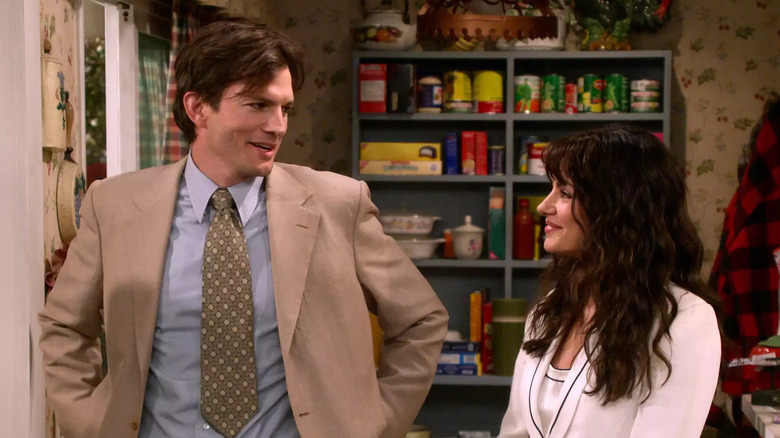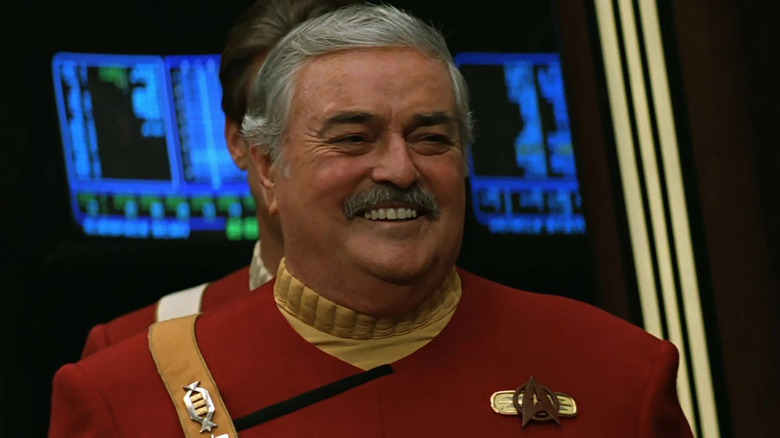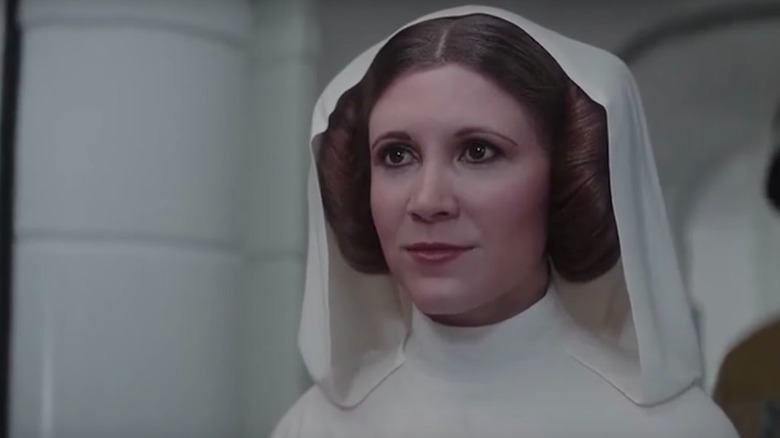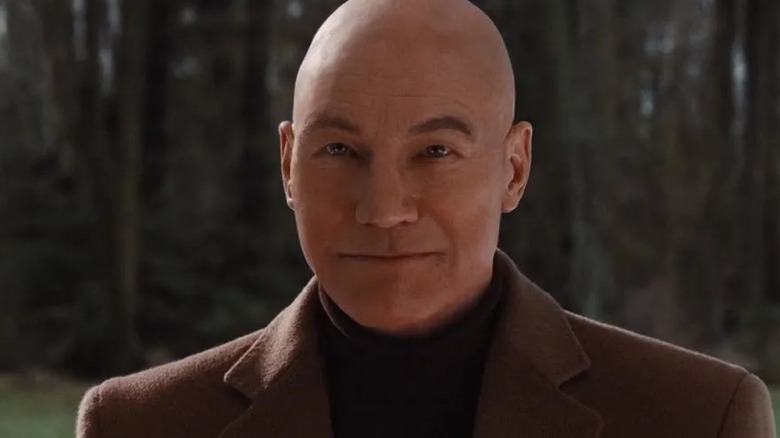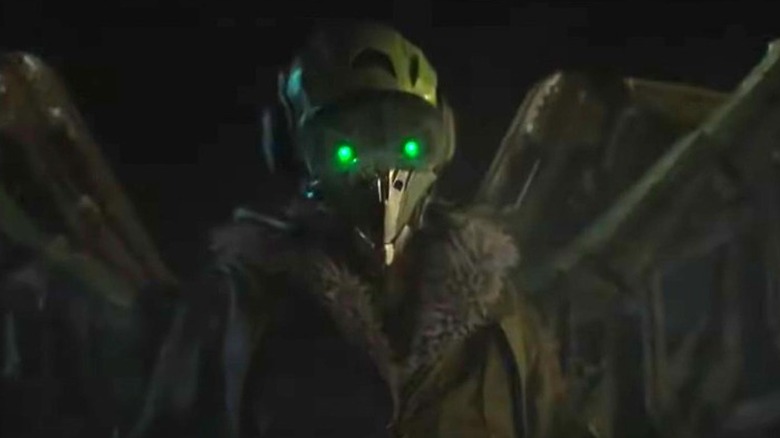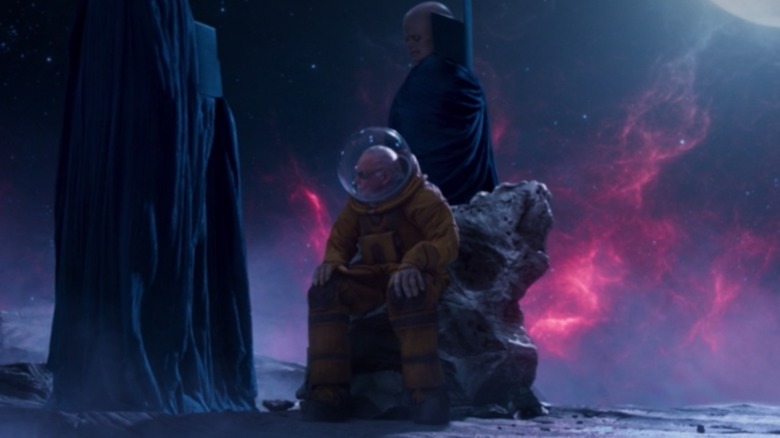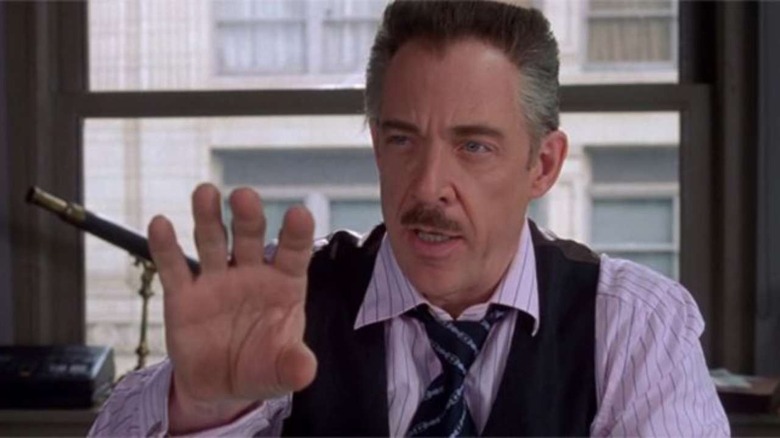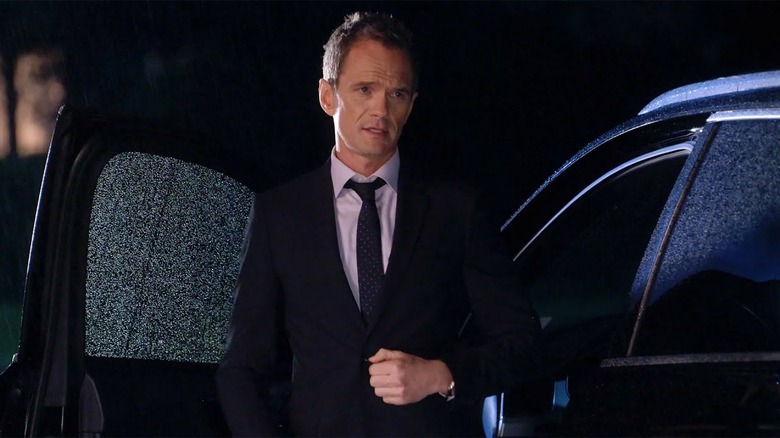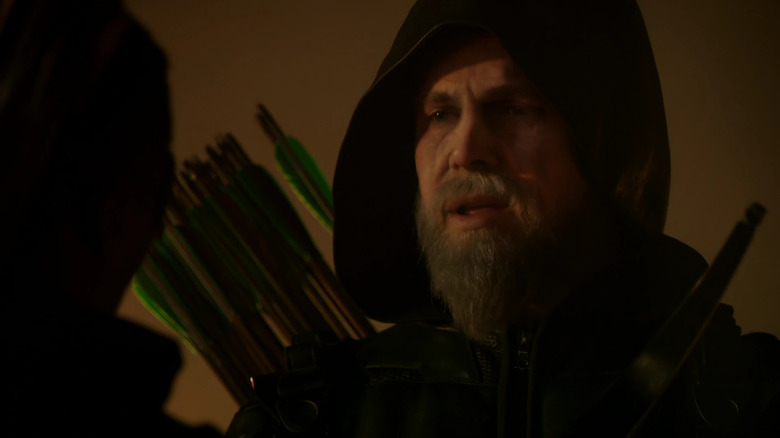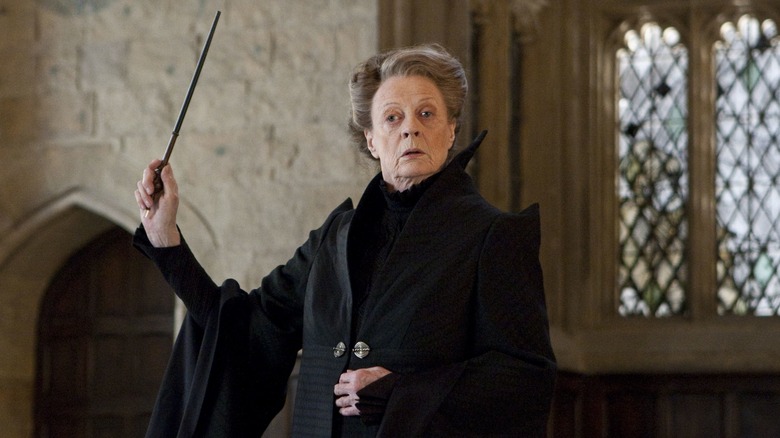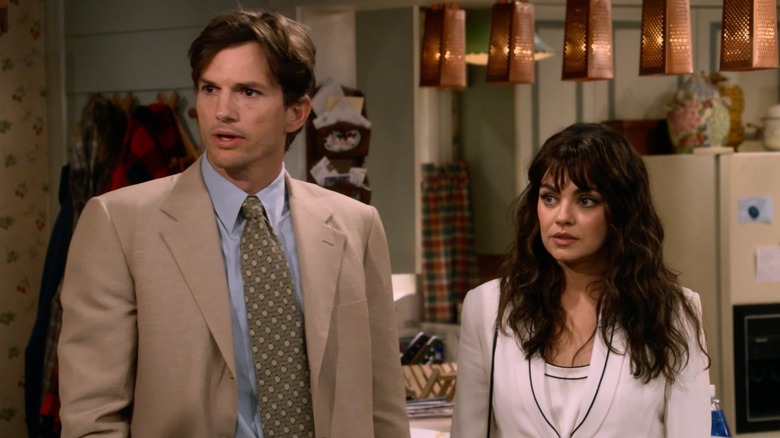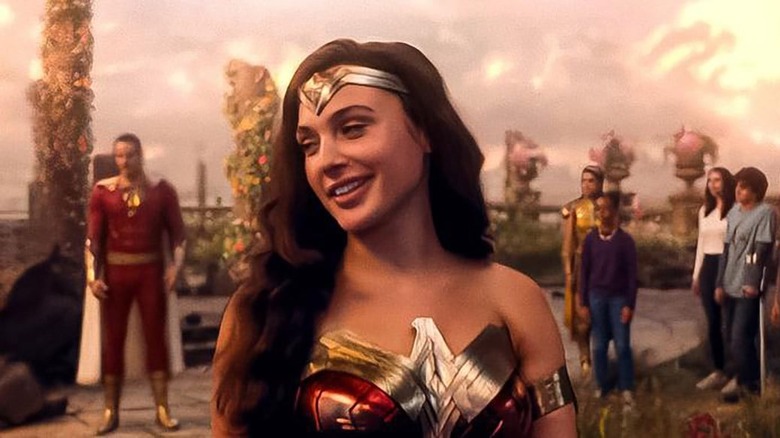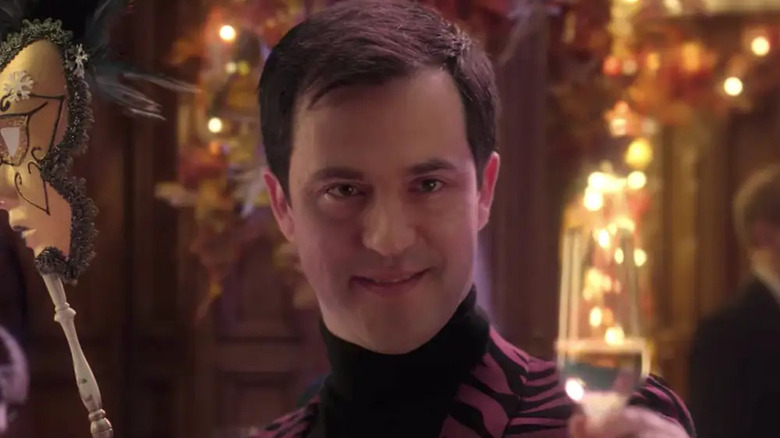Cameos That Created Confusing Plot Holes
In movies and TV shows alike, a good cameo from a fan-favorite character can delight viewers, especially when it comes at an unexpected moment. It's always nice to see a familiar face, even if it's just for a scene or two, and it's all the more exciting when the cameo is someone fans haven't seen for quite a while. Sometimes that's the reason the cameo exists in the first place, as filmmakers hope to create a sense of nostalgia by bringing back a classic character. But every once in a while, those cameos can backfire.
Some cameos have even inadvertently created plot holes that are hard to ignore once they've been spotted. They might not be obvious at first, but given how fandom tends to dissect the most minute details of movies and shows these days, the contradictions these cameos can create are inevitably found by someone. While these seemingly innocent moments can be fun at first, they can also unravel a carefully woven storyline the more that they're scrutinized.
Sure, some filmmakers have later tried to address the problems they create, but many have been outright ignored, leaving fans perplexed to this day. So scroll on as we explore some TV and movie cameos that created confusing plot holes.
Scotty in Star Trek: Generations
In 1994, the crew of "Star Trek: The Next Generation" made the jump to the big screen in a monumental story that saw Captain James T. Kirk meet Captain Jean-Luc Picard. The result was "Star Trek: Generations," and William Shatner wasn't the only classic "Star Trek" actor to make an appearance. In the film's early scenes aboard the USS Enterprise-B, James Doohan also reprises his role as Scotty. It's a brief but memorable cameo where he witnesses the apparent death of James Kirk.
Kirk does manage to return many decades later, but from Scotty's point of view, his former captain is dead and gone. This immediately presented a problem for Trekkies who remembered the "TNG" episode "Relics," which took place chronologically after those scenes on the Enterprise-B. That installment sees the return of Scotty, who survives into the 24th century by keeping himself stored in the transporter. The issue is that when he's revived, he comments that the rescue mission is surely being led by Captain Kirk. But if Scotty had previously witnessed what he believed was Kirk's death, why would he say such a thing?
The truth, of course, is that the writers of that episode didn't know that Scotty would later witness Kirk's "death" in the 1994 film. As for the plot hole, Ron Moore, who wrote both "Relics" and "Generations," has said that he was well aware of the contradiction but let it slide because he wanted to use the character.
Princess Leia in Rogue One: A Star Wars Story
"Rogue One: A Star Wars Story" famously tells the story of how the Rebel Alliance stole the plans for the Death Star and set the stage for the Battle of Yavin seen in the original "Star Wars" film. With such close proximity to an established story — the ending of "Rogue One" takes place mere minutes before the opening of the 1977 classic — the risk of creating massive plot holes was high. Sure enough, that's exactly what happened with a cameo that excited many fans but left some with puzzled looks.
It all happens at the end of the story when the plans are finally in rebel hands after a harrowing escape from the deadly Darth Vader. As the plans are handed off, we get a glimpse at Princess Leia, played by a CGI recreation of Carrie Fisher. Putting aside some sketchy visual effects that many found unconvincing, the very appearance of Leia creates a plot hole. In the original "Star Wars," there's no suggestion that Leia — who nobody knew was a rebel — had been anywhere near a battle with the Empire, let alone involved in a fight with the Sith Lord.
So what was she doing there? Well, the plot hole proved so problematic that Lucasfilm executive Pablo Hidalgo jumped through some story hoops to try to explain it years later on "The Star Wars Show." He claimed that Leia was initially sent to meet up with Obi-Wan Kenobi on Tatooine, but that the Battle of Scarif proved a higher priority, so her ship was rerouted.
Cyclops and Professor X in X-Men Origins: Wolverine
In the first "X-Men" movie in 2000, it's Hugh Jackman's Wolverine who drives much of the film. Serving as the audience surrogate, Logan helps us learn about the world of the X-Men, who all the major players are, and how all the various characters' powers work. His introduction to Charles Xavier, Jean Grey, Storm, and Cyclops is a big part of the film, and it's clearly implied that this is the first time any of them have ever met him.
Flash forward nearly a decade, and after two sequels, Fox wanted to expand the franchise with a Wolverine spin-off. "X-Men Origins: Wolverine" brought the story back to Logan's early days when he first volunteered for the Weapon X program. After a thrilling adventure, Logan escapes the program and helps free a group of mutants from captivity. In the end, they're rescued by Charles Xavier, and one of the freed youngsters is none other than Scott Summers — future X-Man Cyclops — throwing off the timeline and creating a curious plot hole.
None of it really matters in the end, though, since later prequels and sequels wrought so much havoc on the "X-Men" timeline that there are almost too many continuity errors to keep track of at this point.
The Vulture in Morbius
When "Morbius" was first announced by Sony, many wondered how it would connect to the Tom Holland "Spider-Man" movies, if at all. Some figured it would be somehow tied to Holland's wallcrawler in the MCU, yet the appearance of art that looked like Sam Raimi's version of the character cast doubt on that assumption. In a later trailer, fans thought they had their answer with an appearance from Michael Keaton's Adrian Toomes — a role he played in the MCU entry "Spider-Man: Homecoming." When the movie was finally released, however, it left more questions than answers.
That's because the movie is clearly set in its own separate universe, and when Toomes shows up in a post-credits scene, he's apparently crossed over from the MCU. But it makes no sense because Toomes is suddenly back in his Vulture outfit and seems strangely evil, despite being jailed in his last moments in "Homecoming" and determined to turn over a new leaf.
Two years later, this plot hole was seemingly closed by the 2023 film "Spider-Man: Across the Spider-Verse." There it's explained that Dr. Strange's multiversal spell-gone-wrong in "Spider-Man: No Way Home" left heroes and villains alike in the wrong universes, suggesting that the version of Toomes seen in "Morbius" might not be the same one from "Homecoming" at all.
Stan Lee in Guardians of the Galaxy Vol. 2
Beginning with his blink-and-miss-it appearance in "The Trial of the Incredible Hulk," in which he played an unnamed juror, Marvel icon Stan Lee made a career out of cameos. Showing up in a slew of Marvel productions on both TV and film, his appearances usually provided both nostalgic fuzzy feelings and a good laugh at the same time. But when he turned up in "Guardians of the Galaxy Vol. 2," director James Gunn used a wild fan theory to turn his appearance into something more. Unfortunately, it also left some fans pointing out a glaring plot hole in the process.
In the film, Lee plays himself, but this time he's in outer space commiserating with a pair of alien "Watchers." He explains that he's been to Earth many times and taken many forms, suggesting that every cameo he's ever made has actually been the same character. The problem with this, however, is that in the scene, he mentions having been a FedEx delivery person — a nod to his cameo in "Captain America: Civil War." This causes problems because, chronologically, "Guardians of the Galaxy Vol. 2" actually takes place well before "Civil War."
Gunn later explained this plot hole away by suggesting that Lee's character probably posed as a FedEx worker on other occasions. The likely truth, though, is that Gunn just wasn't paying attention to the order of the films when he wrote the scene.
J. Jonah Jameson in Spider-Man: No Way Home
The 2021 blockbuster "Spider-Man: No Way" was packed with cameos, from the show-stopping reveals of Tobey Maguire and Andrew Garfield to the unexpected appearance of Charlie Cox as Matt Murdock. But only one cameo seemed to create a glaring plot hole — not a storytelling contradiction, but rather a curious bit of multiverse madness. That would be the return of J.K. Simmons as J. Jonah Jameson. Though he previously appeared in a single scene in "Spider-Man: No Way Home," it's the broader multiverse story of the threequel that makes him a sudden head-scratcher.
Consider for a moment that every other character in the "Spider-Man" universe is apparently different across the various universes, with the likes of Peter Parker, Mary Jane, Aunt May, and Flash Thompson all played by different actors between the three film series. With that in mind, why is J. Jonah Jameson played by the same actor as in Raimi's trilogy? It stands out as particularly unusual because every other returning actor plays their original incarnation, not a new version, which could have left some to believe that Jameson had crossed over from the Raimi reality. Of course, the real reason is likely that the studio simply couldn't imagine anyone else in the role, and it's hard to argue with that rationale.
Barney in How I Met Your Father
In 2022, Hilary Duff began starring in the spin-off series "How I Met Your Father." Indirectly related to its wildly successful parent series, "How I Met Your Mother," the show centers on Sophie, a woman in the year 2050 who recounts to her son the story of — you guessed it — how she met his father. But just because Sophie is an entirely new character and the series is set many years later doesn't mean there's no crossover with "How I Met Your Mother." In fact, a handful of characters from the original show have popped up, including Cobie Smulders as Robin Scherbatsky.
Robin — one-time wife of Barney Stinson on "How I Met Your Mother" — was once a pop star, but she eventually transitioned into a career as a news reporter. When she bumps into Sophie, she professes her adoration for Robin, whose life and career she's followed with great interest. That's all well and good, but later in the season Sophie also bumps into Barney via a minor fender bender. It's a nice moment for the audience to see an old face, but to Sophie, he's just another random motorist. Some have pointed out, though, that if she was so intimately familiar with the details of Robin's life, she maybe should have recognized her idol's ex-husband.
Oliver Queen in Legends of Tomorrow
It seems like superhero cameos are always causing problems, so it's probably no surprise that the Arrowverse is next up on our list. A sprawling universe of interconnected shows, the Arrowverse has featured time travel, alternate reality doppelgangers, clones, and extensive use of flashbacks, making it a spawning ground for potential plot holes. But the biggest may have come in the team-up series "Legends of Tomorrow" when a glimpse into the future saw Stephen Amell guest star as Green Arrow in the episode "Star City 2046."
In a story that used Amell as an obvious attention-grabber in the show's first season to woo new viewers, the super-team arrives in the future only to discover that they've failed to stop the villain Vandal Savage. The world is in ruin, and supervillains are everywhere. But that creates a bit of a problem because other episodes of the series, and even flash-forwards in "Arrow," never make any mention of this terrifying future. Three years later, fans got an explanation in the "Crisis on Infinite Earths" crossover event. There, it's explained that the dark future seen in that episode was actually a different timeline altogether.
Minerva McGonagall in Fantastic Beasts
"Fantastic Beasts and Where to Find Them" was an attempt to create a second long-running franchise from the Wizarding World. While it hasn't been met with nearly the same level of success as the "Harry Potter" series, it has delivered some interesting new stories and fun characters, and the cast alone is enough to keep audiences coming back. But it also wound up introducing a major plot hole thanks to a cameo from Minerva McGonagall in "Fantastic Beasts: The Crimes of Grindelwald."
Played by Dame Maggie Smith in the "Harry Potter" films, the role is taken on by Fiona Glascott in "The Crimes of Grindelwald." She's a much younger version of the character, and that creates a mess of timeline problems. We know from putting together various details given in the earlier "Potter" material that McGonagall began attending Hogwarts herself as a student at the age of 11 in 1947, and she started teaching there in 1956. So when McGonagall shows up in scenes in the newer film set in 1927, some eight years before she would have been born, we're left with a massive continuity failure.
To make matters worse, the films double down on the error by giving McGonagall an even bigger role in the third film, "Fantastic Beasts: The Secrets of Dumbledore." There she's already a Hogwarts instructor in 1937 — when she should have been just two years old — and is once again played by Glascott in her late 30s.
Mila Kunis and Ashton Kutcher in That '90s Show
"That '70s Show" was one of the biggest sitcoms of the late '90s and early 2000s, following a group of teens in the era of shag carpet and bellbottoms. It tried an unsuccessful sequel, "That '80s Show," in 2002, but it finally got the spin-off formula right 20 years later with "That '90s Show." The new series on Netflix brings back some of the main cast in regular roles, as Red and Kitty spend the summer with their granddaughter, Leia Foreman. The series also gives guest-starring roles to former cast members Wilmer Valderrama, Topher Grace, and Laura Prepon, but it's the appearance of Mila Kunis and Ashton Kutcher that lands on this list.
The duo returns as Kelso and Jackie right off the bat, guest-starring in the series premiere as a married couple who reveal that Leia's friend Jay is their son. The revelation is a fun one, but it doesn't jive with what we knew of "That '70s Show" previously because the two lovebirds had broken up by the end of the series. Jackie actually walked off into the sunset with Fez. Sure, a lot of time passed between then and now, but there's absolutely no explanation given for the swap. That probably has more to do with the fact that fans liked the pairing better, and that the actors are married in real life.
Wonder Woman in Shazam! Fury of the Gods
The blend of gods and monsters in the DCEU has always been a little bewildering, but audiences got a little clarity with "Shazam! Fury of the Gods." The film features the arrival of the Daughters of Atlas, a trio of women gods who return from imprisonment to wreak havoc on Earth. It's explained that when the Wizard created the staff imbued with the powers of Solomon, Hercules, Atlas, Zeus, Achilles, and Mercury, he used it to prevent the gods from entering the mortal realm.
In the first "Shazam!" film, it's the breaking of that staff that frees the gods and sets the stage for "Fury of the Gods," but the sequel includes a cameo that creates a little problem with all of that. If the gods had been sealed away for some thousands of years, then the presence of Wonder Woman — a goddess and daughter of Zeus — is an unexplainable anomaly. She seems well acquainted with the Wizard's staff, too, which has made many wonder how she was able to fight in World War I, and likewise, how Aries was able to do the same and battle her in the first "Wonder Woman" film.
Some have speculated that perhaps the Amazon island of Themyscira is separate from the gods' realm affected by the Wizard's staff. But with no concrete explanation, it remains another unresolved plot hole that may never be answered now that the DCEU is being effectively erased.
Simon in The Princess Switch 3
Not all plot holes are strictly story-related. Some come in the form of confusing moments that simply make no sense whatsoever. Such is the case with a series of cameos in the "Princess Switch" films — a set of holiday movies from Netflix starring Vanessa Hudgens. In the films, Hudgens plays dual roles as both Stacy De Nobo, an ordinary woman from Chicago, and Lady Margaret Delacourt, a royal Duchess.
Ala "The Prince and the Pauper," the films see the two women switching places to have a jolly good time, but the movies also include cameos from another Netflix holiday movie series, "The Christmas Prince." Perhaps in an attempt to create some sort of bizarre Netflix yuletide universe, the second film features a cameo from Queen Amber (Rose McIver), King Richard (Ben Lamb), and their baby Elleri as audience members in a coronation scene. But the threequel doubles down, with Simon (Theo Devaney) turning up and introducing himself as the Duchess' pal.
How is this a plot hole? Well, in the first "Princess Switch" movie, Stacy is seen watching "The Christmas Prince" on TV. It's more than just a background Easter egg, as Stacy even comments that it's her favorite film. And yet, when she meets one of that movie's main characters in "The Princess Switch 3," she makes absolutely nothing of the fact that she's just said hello to a character from a movie.
